February in the Natural Garden
- Posted in: Blog, Monthly Garden Advice
- Tags Garden Maintenance, Seasonal Gardening, Words by Mike Evans
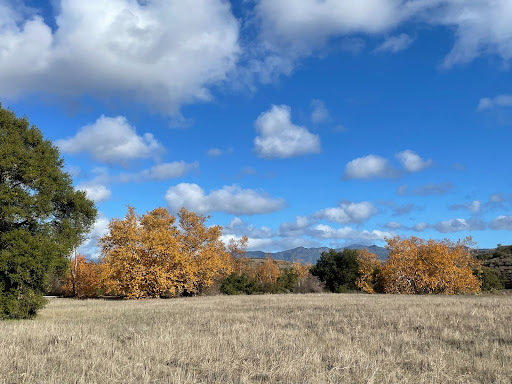
February in the Natural Garden
Sorry about January. It didn’t rain. That’s not my fault, but I’m sorry anyway, especially that I did not write a monthly gardening newsletter. That is my fault. I couldn’t find the inspiration. January is a winter month and winter should mean rain in southern California. When our actual weather and all the forecasts offered only warm sunny days (with a few cold nights), plus more than our fair share of drying winds, I simply gave up on writing garden advice and got into documentary photography while wandering around noticing subtle changes in the garden. Also, listening to the wind, as well as tidying up everything the gusts blew down, and oh yeah, watering to keep garden plants from drying out.
Current events, history, review, and notes
We got, at long last, a nice rain mid month, one soaking event providing about 1.5”, which remarkably is one half the total for our February 2022. We have received 5.75” rain to date, 3” of which came in one satisfactory mid-December event. Last year our total for the entire season was 5.67”, definitely a drought year number. The prior year, 2019-20 was great with 18.59”, around 5 or 6” above average. All this to say that in our natural areas and abandoned landscape spaces, the deep moisture that is so important for plant health is basically gone at this point. Dried up. The good news is that February, March, and April bear the potential to bring us some good storms, so all hope for more rain is not lost. In the meantime, keep an eye on your plants, especially thinking about deep soaks on established gardens in lieu of rainfall.
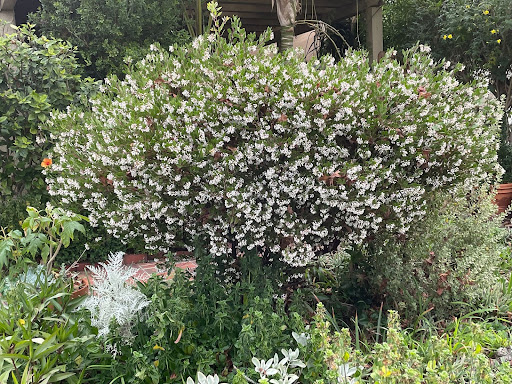
Arctostaphylos ‘Howard McMinn’
Watering
As a general rule, native plants start growing in spring as the soils warm and the daylight hours increase. They find the water deep in their root zones, moisture that has been accumulating during the rainy months of November, December, and January. After a dry winter like ours so far, spring growth occurs over a shorter period and is less luxuriant. If February, March and even April turn wet, things will get better for our plants, their spring growth cycle will be extended, and moisture will be present all summer to maintain their overall health through that long dry season.
In this dry winter, it’s a good idea to give trees and shrubs at least one thorough soaking per month, applying the equivalent of 1-2” precipitation each time. We call this a Deep Soak and it’s like putting money in the bank so you can make withdrawals as needed later. We cannot substitute for the high quality of rainwater, but fortunately we can substitute its quantity in a pinch. The plants will tap into their water reserves at the return of warm weather.
Related to Watering
With minor adjustments to the soil surface in your garden, you can get a lot more rainwater to penetrate deep into your soil. Between In addition to dry soil, dry leaves and dust can be problematic, especially in winter. Feel free to wash off your leaves and wet the soil surface frequently with what we call Refreshing Sprinkles.
Pruning
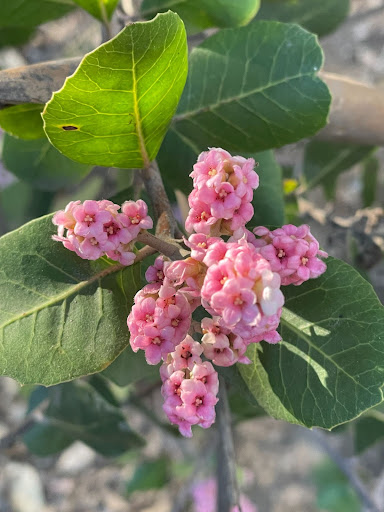
This is the ideal time for pruning all deciduous trees and shrubs like sycamore, alder, willow, dogwood, ash, walnut, black oak, valley oak, elderberry, desert olive, redbud, desert willow, buffalo berry, mock orange, currants, some gooseberries, and wild grape. Same with stone fruits, peaches, plums, cherries, etc. You can open up the plant’s structure, removing dead and diseased branches first, then branches that are duplicating, crossing, or downward heading. With some trees (and definitely your fruit trees) you’ll want to head back some of last year’s new growth to encourage healthy branching this season.
Be careful if you want to prune evergreen shrubs. Many spring flowering natives are producing flower buds this month and you will be affecting their spring bloom dramatically if you prune now.
For most woody shrubs, shaping should be done in fall, heading back in early summer. Semi-woody subshrubs like sage and buckwheat can be tip pruned all year, but major pruning is usually done at the end or at the very beginning of their growing season (May or October). If you have some sage, sagebrush, buckwheat, sunflower or other semi-woody plants that need a new life, it’s ok to cut them back now. You may sacrifice some flowers, but you’ll get verdant new growth in spring, just around the corner.
Weeding
Keep up on weeding. Call or write if you’re having trouble distinguishing weed seedlings from wildflower seedlings you sowed last fall.
Mulching/Top Dress
Watch carefully as your plants provide their own mulch over the root zone; it’s a wonderful process. If you want to import organic topdress from an outside source, clean chunky natural bark products are best. Avoid smelly composts and cheap wood grindings of unknown origin.
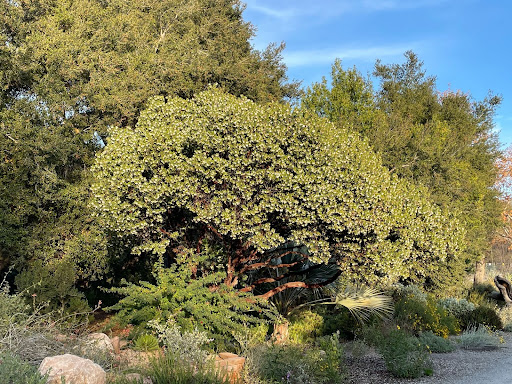
Feeding
You can get a jump on the season by making a light application of a balanced organic fertilizer, dry (or granular) from a bag. Follow label instructions or use slightly less. Scratch it into the top half inch of soil and water thoroughly. Repeat in March and/or April.
Troubleshooting – Varmints, Pests and Diseases
Gophers never took a rest and their tunnels so far have not been flooded this year. They can cause a lot of damage in a very short time. Write GardenHelp (details below) with specific questions about treatments for gophers. Explicit explanations regarding trapping have been found odious to some newsletter readers in the past.
Watch for Argentine ants which can be problematic on root systems and on stems and leaves if they are farming mealybug or scale. Big chewed holes in leaves may be beetle larvae. Once you see the damage, it’s almost too late to find the culprit, but perhaps a bird did find it, problem solved. If you see shiny bright red galls and grotesquely twisted leaves on the new growth of manzanita, this is manzanita leaf gall aphid. The best control is to cut off the affected twigs and discard them in the trash. As a general rule, natural gardens might harbor plant pests periodically, but the damage is usually light and brief, as natural predators are close by to take care of the problems.
Annual Wildflowers
February is a month almost too late to sow seed and still expect spring flowers. Amazingly, the dry winter has bought you some time though, so get on it if you have not already done this. But hurry. Your window is closing fast.
Adding New Plants
This window is wide open. Fall, winter, and spring are the best times to plant. Come on over. We have lots of new species and varieties, as well as the old stand-bys in good supply. Remember that new plants in the garden still have all their feeder roots inside the root ball of the nursery container. You have to prevent that root ball from drying out by watering it every few days for the first couple months.
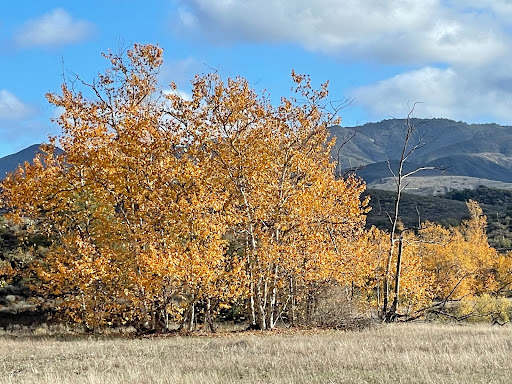
A fine little grove of California sycamore
Phytophilia
Literally translated “brotherly love of plants,” this new section in our monthly newsletter will specifically address the “sixth sense” we can develop in our relationship to plants in general, and specifically to plants in our gardens. This month, be observant of all new growth; flower buds or leaf buds, especially before they open. You can look at them on the same day, morning and evening and perhaps see a difference. You can hold a tender new branch tip in your fingers, close your eyes, and “feel” the life of the plant as you imagine a mature branch in this very place come summer. Watch the hummingbirds find your manzanita blooms as they feed all day non-stop. When an individual flower is all nectared out, it falls to the ground. The gatherings of these fallen flowers will remind you it’s still winter, for they look like drifts of snow!

Engage
The thing about deserts is that changes occur slowly and in almost unnoticeable fashion over decades or centuries. Until it rains. Then dramatic changes are rapid and fleeting as wildflowers bloom, shrubs leaf out, insects abound, and frogs and all manner of creeping things seem to come out of nowhere. For almost two years, our winters on the coast have been comparable to winters in our southern deserts. Think Yuma. But our natural gardens benefit from our diligent care, including irrigation in the dry season and the supplemental water during winter dry spells, so our gardens can look Californian, even when our weather is Sonoran.
Especially during drought periods, our natural gardens become rich oases, each one a green bullseye on the big target for local songbirds, hummingbirds, butterflies and other beneficials. A simple water source like a fountain or bird bath proves to be an additional invaluable habitat in even the smallest garden space.
And soon come the flowers! Come flowers come. With or without more rain, we can make our gardens beautiful and our little birds happy. Stay focused. And if peradventure we get a deluge during the four cool months remaining before summer, we’ll have more reason to celebrate!
Hey, it’s a new year! Let’s start makin’ it!
From the FEBRUARY (and JANUARY) Garden,
Mike Evans
Questions? Help is just one call or one email away. Call (949) 728-0685 or email (with pictures if you like) our special helpline: gardenhelp@californianativeplants.com